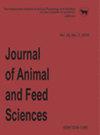稀释鸡粪生产浮萍
IF 1.5
4区 农林科学
Q3 AGRICULTURE, DAIRY & ANIMAL SCIENCE
引用次数: 0
摘要
. 本研究的目的是试验鸡粪作为浮萍(lena minor)肥料。浮萍用三种不同的浓度(低、中、高)生长;稀释系数分别为1:16,1:12和1:8)先前溶解的鸡粪。随后,对浮萍的鲜、干生物量产量、蛋白质含量和蛋白质产量进行了评价本文章由计算机程序翻译,如有差异,请以英文原文为准。
Duckweed production on diluted chicken manure
. The aim of this study was to test chicken manure as duckweed ( Lemna minor ) fertiliser. Duckweed was grown using three different concentrations (low, medium and high; dilution factors 1:16, 1:12 and 1:8, respectively) of previously solubilised chicken manure. Subsequently, duckweed was evaluated for its fresh and dry biomass production, protein content and protein production
求助全文
通过发布文献求助,成功后即可免费获取论文全文。
去求助
来源期刊

Journal of Animal and Feed Sciences
农林科学-奶制品与动物科学
CiteScore
2.10
自引率
0.00%
发文量
42
审稿时长
3 months
期刊介绍:
Journal of Animal and Feed Sciences (JAFS, J. Anim. Feed Sci.) has been published by the Kielanowski Institute of Animal Physiology and Nutrition, Polish Academy of Sciences in Jabłonna (Poland) since 1991. It is a continuation of the Polish-language journal Roczniki Nauk Rolniczych. Seria B, Zootechniczna published by the Polish Academy of Sciences since 1969.
JAFS is an international scientific journal published quarterly, about 40 papers per year including original papers, short communications and occasionally reviews. All papers are peer-reviewed and related to basic and applied researches in the field of animal breeding and genetics, physiology of nutrition, animal feeding, feed technology and food preservation. The journal distinguishes the multidisciplinary nature of physiological and nutritional sciences and so includes papers specialized in all fields connected with animal well-being, including molecular and cell biology and the emerging area of genetics.
 求助内容:
求助内容: 应助结果提醒方式:
应助结果提醒方式:


